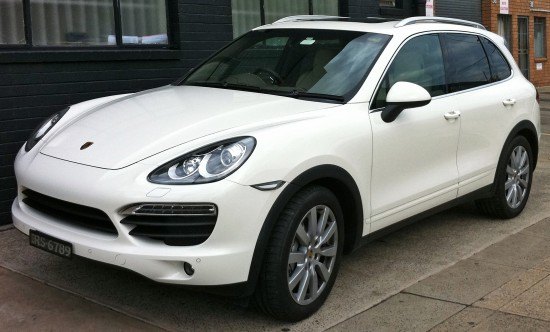Porsche Cayenne Diesel Coming To America In 2012
Forget Amerindian prognostications of the apocalypse occurring in 2012 – the sight of an oil-burning Porsche SUV is enough for some to consider it the end of the world.
The announcement of a diesel powered Porsche Cayenne was buried deep within a press release for the Porsche 911 Cabriolet’s debut at the 2012 North American International Auto Show. According to the release, the spring launch of the previously revealed Panamera GTS “…will subsequently be followed by the Cayenne Diesel as Porsche’s first compression-ignition car in the USA.”
Pricing and positioning for the Cayenne Diesel hasn’t been announced, but we can look to both the existing Cayenne lineup as well as its competitors for clues. The current Cayenne lineup has the Cayenne V6 at $48,200, while the V8-powered Cayenne S retails for $65,000. The Hybrid model (with a supercharged V6 and hybrid drivetrain is $69,000. The diesel will have to bridge the substantial gulf between the two cars, and given Porsche’s propensity to charge exorbitant sums for trivial widgets like colored wheel crests, look for the Cayenne Diesel to err towards the higher side of the pricing spread.
BMW and Mercedes-Benz offer their own range of diesel engines on certain SUVs (the X5, M-Class and GL-Class. The R-Class is questionable as an SUV), but their pricing strategy differs as widely as their respective marketing narratives. BMW positions the X5 diesel as a much more expensive option – costing some $9200 more than a base X5 35i with the 3.0L twin-turbo I6, while the Mercedes ML350 BlueTEC carries a premium of $1590. The GL350 BlueTEC on the other hand costs $1000 less than the base gasoline GL450.
More by Derek Kreindler
Latest Car Reviews
Read moreLatest Product Reviews
Read moreRecent Comments
- Dr.Nick What about Infiniti? Some of those cars might be interesting, whereas not much at Nissan interest me other than the Z which is probably big bucks.
- Dave Holzman My '08 Civic (stick, 159k on the clock) is my favorite car that I've ever owned. If I had to choose between the current Civic and Corolla, I'd test drive 'em (with stick), and see how they felt. But I'd be approaching this choice partial to the Civic. I would not want any sort of automatic transmission, or the turbo engine.
- Merc190 I would say Civic Si all the way if it still revved to 8300 rpm with no turbo. But nowadays I would pick the Corolla because I think they have a more clear idea on their respective models identity and mission. I also believe Toyota has a higher standard for quality.
- Dave Holzman I think we're mixing up a few things here. I won't swear to it, but I'd be damned surprised if they were putting fire retardant in the seats of any cars from the '50s, or even the '60s. I can't quite conjure up the new car smell of the '57 Chevy my parents bought on October 17th of that year... but I could do so--vividly--until the last five years or so. I loved that scent, and when I smelled it, I could see the snow on Hollis Street in Cambridge Mass, as one or the other parent got ready to drive me to nursery school, and I could remember staring up at the sky on Christmas Eve, 1957, wondering if I might see Santa Claus flying overhead in his sleigh. No, I don't think the fire retardant on the foam in the seats of 21st (and maybe late 20th) century cars has anything to do with new car smell. (That doesn't mean new car small lacked toxicity--it probably had some.)
- ToolGuy Is this a website or a podcast with homework? You want me to answer the QOTD before I listen to the podcast? Last time I worked on one of our vehicles (2010 RAV4 2.5L L4) was this past week -- replaced the right front passenger window regulator (only problem turned out to be two loose screws, but went ahead and installed the new part), replaced a bulb in the dash, finally ordered new upper dash finishers (non-OEM) because I cracked one of them ~2 years ago.Looked at the mileage (157K) and scratched my head and proactively ordered plugs, coils, PCV valve, air filter and a spare oil filter, plus a new oil filter housing (for the weirdo cartridge-type filter). Those might go in tomorrow. Is this interesting to you? It ain't that interesting to me. 😉The more intriguing part to me, is I have noticed some 'blowby' (but is it) when the oil filler cap is removed which I don't think was there before. But of course I'm old and forgetful. Is it worth doing a compression test? Leakdown test? Perhaps if a guy were already replacing the plugs...


































Comments
Join the conversation
Is this another Euro-diesel that needs the uric acid/pee tank filled @ great expense?
To quote an article by Jens Meiners in Automotive News in March of '04: "We don't tend to follow the competition," said Wolfgang Dürheimer, Porsche's executive vice president for research and development. Of the 40,000 Cayennes that Porsche is selling annually, over half go to North America, where there is no demand for diesel SUVs. "We don't want to develop an engine for just 5,000 units," Dürheimer said. "An SUV by Porsche must be agile and sporty, but you need an engine willing to rev, which a diesel isn't." I guess that things change over the years.